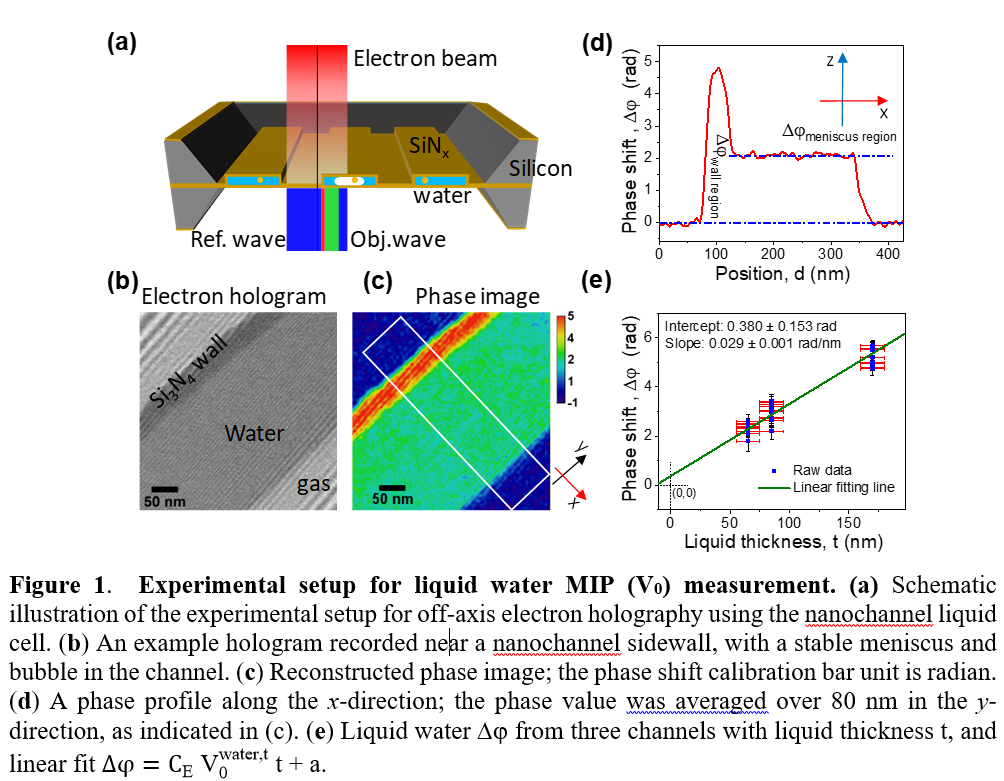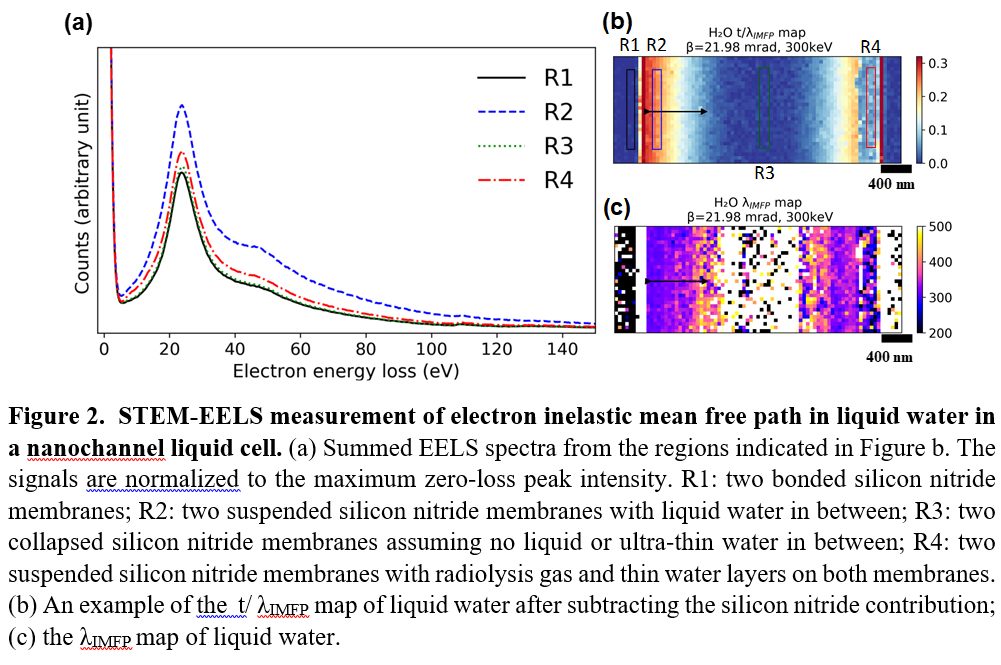Quantitative analysis of water intrinsic properties in liquid phase transmission electron microscopy
- Abstract number
- 419
- Presentation Form
- Poster & Flash Talk
- Corresponding Email
- [email protected]
- Session
- Poster Session One
- Authors
- Assistant professor Murat Nulati Yesibolati (3), Senior researcher Shima Kadkhodazadeh (3), Dr. Shawn M. Kathmann (2), Associate professor Marco Beleggia (3), Professor emeritus Ole Hansen (3), Senior Scientist Nestor J. Zaluzec (1), Professor Kristian Mølhave (3)
- Affiliations
-
1. Argonne National nLaboratory
2. Pacific Northwest National Laboratory
3. Technical University of Denmark
- Keywords
liquid phase transmission electron microscopy, mean inner potential, inelastic mean free path, water, holography, electron energy-loss spectroscopy
- Abstract text
Summary and Introduction: Over the past two decades, ultra-thin electron transparent membranes e.g. graphene, silicon nitride[1], boron nitride have been widely used as window materials in liquid phase transmission electron microscopy(LPTEM). Thin liquid layer is sandwiched in between two membranes, allowing to investigate the evolution of materials’ morphology, crystal phase and chemistry in-situ in their native liquid environment down to atomic scale at micro/mill second temporal resolution. As such, LPTEM can shed light on fundamental questions in physics, materials science, chemistry, soft matter and bioscience[2].
Methods/Materials: Here we present studies of mean inner potential (MIP, V0) of liquid water [3], and electron inelastic mean free path ( λIMFP) in liquid water[4] using an advanced nanochannel liquid cell [5] in TEM.
Results, Discussion and Conclusions:MIP of liquid water: The unscattered electrons’ phase shift after passing through the sample carry information of the samples atomic constituents and potentials. Improving our experimental and theoretical knowledge of electric potentials at liquid-solid boundaries is essential to achieve a deeper understanding of the driving forces behind interfacial processes. Electron holography [6] has proved successful in probing solid-solid interfaces, but requires knowledge of the materials’ mean inner potential (MIP, V0), which is a fundamental bulk material property. Combining off-axis electron holography with LPTEM as shown in Figure 1, we provide the first quantitative MIP determination of liquid water V0=+4.48±0.19 V [3]. This value is larger than most theoretical predictions and experiment values[7,8] and to explain the disagreement we assess the dominant factors needed in quantum simulations of liquid water[9]. A precise MIP lays the foundations for nanoscale holographic potential measurements in liquids, and provides a benchmark to improve quantum mechanical descriptions of aqueous systems and their interfaces in e.g. electrochemistry, solvation processes and spectroscopy.
Electron λIMFP in liquid water: In general, knowledge of the water thickness is needed for reliable interpretation and modeling of many analytical studies in LPTEM. Having a precise measure of this parameter is particularly essential when using thin liquid layers, which is essential for achieving ultra-high spatial resolutions, or phase imaging [10]. The electron energy-loss spectroscopy (EELS) log-ratio method is often applied in TEM to estimate the sample thickness relative to the inelastic mean free path (λIMFP) [11,12]. However,λIMFP itself is dependent on the specific sample material, the electron energy, and the angular conditions and electron optics of the microscope electron optics. The electron scattering λIMFP of water was measured using the nanochannel liquid cell, as shown in Figure 2. The results are compared to previous experimental studies on water and ice, and two theoretical models [11-13]. We observe good agreement with the studies conducted on ice [14] but find that the widely accepted theoretical models significantly underestimate λIMFP of water. Using an adjusted average energy-loss term, Em,water, we find far better agreement between the model and observations. The results are highly valuable, as a comprehensive knowledge of the lIMFP of water (or ice) under different electron optics conditions ensures reliable interpretation and quantification of observations in LPTEM and many cryo-TEM studies.
- References
References:
[1] M. J. Williamson et al., Nature Materials 2 (2003), p. 532
[2] F. M. Ross, Science 350 (2015)
[3] M. N. Yesibolati et al., Physical Review Letters 124 (2020), p. 065502
[4] M. N. Yesibolati et al., Nanoscale 12 (2020), p. 20649
[5] S. Lagana et al., Microelectronic Engineering 176 (2017), p. 71
[6] E. Völkl et al., Introduction to Electron Holography (Kluwer Academic/Plenum Publishers, New York, 1999).
[7] B. Sellner and S. M. Kathmann, The Journal of Chemical Physics 141 (2014), p. 18C534
[8] A. Harsher and H. Lichte, Inelastic mean free path and mean inner potential of carbon foil and vitrified ice measured with electron holography (Iop Publishing Ltd, Bristol, 1998), Electron Microscopy 1998, Vol 1: General Interest and Instrumentation.
[9] R. C. Remsing et al., The Journal of Physical Chemistry Letters 5 (2014), p. 2767
[10] N. de Jonge, Ultramicroscopy 187 (2018), p. 113
[11] T. Malis et al., JOURNAL OF ELECTRON MICROSCOPY TECHNIQUE 8 (1988), p. 193
[12] R. F. Egerton and S. C. Cheng, Ultramicroscopy 21 (1987), p. 231
[13] K. Iakoubovskii et al., Microscopy Research and Technique 71 (2008), p. 626
[14] R. F. Egerton, in Proc. 50th Annual EMSA Meeting, edited by J. B. a. J. A. S. ed. by G.W. Bailey (San Francisco Press, San Francisco, 1992), pp. pp. 1264.


